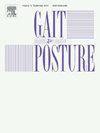Walking speed and incline impact on mediolateral-stability control
IF 2.2
3区 医学
Q3 NEUROSCIENCES
引用次数: 0
Abstract
Background
Controlling and stabilizing the body are crucial for walking on an inclined path. Healthy individuals adjust their gait to improve stability by reducing stride length and increasing cadence. Incline influences anteroposterior stability; however, its effects on mediolateral stability are inconclusive.
Research question
What are the effects of walking inclination and speed on mediolateral stability using foot placement quantified by explained variance (EV)?
Methods
Fifteen healthy young adults walked on a treadmill under four speed (moderate 0.83 m/s, fast 1.0 m/s) and grade (0 and +6° inclines) combinations. The participants wore markers and surface electromyography (EMG) electrodes. A motion-capture system captured the three-dimensional marker data. The relative EV was used to calculate the ratio between the predicted and actual foot-placement variances. The EV and EMG parameters were tested to identify statistically significant differences between conditions.
Results
Two-way analysis of variance revealed no significant interaction between the condition and speed in EV and most EMG measurements, except for the vastus medialis (p = 0.03). Additionally, speed and incline significantly affected all EMG values (p = 0.001–0.04 and 0.0001–0.003, respectively); however, incline did not affect EV. The EMG was higher in incline than in the level condition.
Significance
Foot placement was used to identify the effects of walking inclination and speed on mediolateral stability control. Walking speed and incline affect mediolateral stability and muscle activation differently, with higher speeds improving stability and incline increasing quadriceps activation. This highlights the need to incorporate varied speeds and targeted muscle strengthening in rehabilitation.
行走速度和坡度对中侧稳定性控制的影响
在倾斜的道路上行走,控制和稳定身体是至关重要的。健康的人通过减少步幅和增加步频来调整步态以提高稳定性。倾斜对前后稳定性有影响;然而,其对中外侧稳定性的影响尚无定论。研究问题:用解释方差(EV)量化脚位时,行走倾斜度和速度对中外侧稳定性的影响是什么?方法15名健康青年在跑步机上以4种速度(中速0.83 m/s,快速1.0 m/s)和坡度(0°和+6°倾斜)组合行走。参与者佩戴标记和表面肌电图(EMG)电极。一个动作捕捉系统捕获了三维标记数据。相对EV用于计算预测与实际脚位方差之间的比值。测试EV和EMG参数,以确定两种情况之间的统计学差异。结果双向方差分析显示,除股内侧肌外,大多数肌电图测量值与EV状态和速度无显著交互作用(p = 0.03)。此外,速度和坡度显著影响所有肌电值(p分别为 = 0.001-0.04和0.0001-0.003);倾斜度对EV没有影响。倾斜状态下肌电图明显高于水平状态。意义:采用足部放置来确定行走倾角和速度对中外侧稳定性控制的影响。步行速度和倾斜度对中外侧稳定性和肌肉激活的影响不同,步行速度越快,稳定性越好,倾斜度越大,股四头肌的激活程度越高。这突出了在康复中需要结合不同的速度和有针对性的肌肉强化。
本文章由计算机程序翻译,如有差异,请以英文原文为准。
求助全文
约1分钟内获得全文
求助全文
来源期刊

Gait & posture
医学-神经科学
CiteScore
4.70
自引率
12.50%
发文量
616
审稿时长
6 months
期刊介绍:
Gait & Posture is a vehicle for the publication of up-to-date basic and clinical research on all aspects of locomotion and balance.
The topics covered include: Techniques for the measurement of gait and posture, and the standardization of results presentation; Studies of normal and pathological gait; Treatment of gait and postural abnormalities; Biomechanical and theoretical approaches to gait and posture; Mathematical models of joint and muscle mechanics; Neurological and musculoskeletal function in gait and posture; The evolution of upright posture and bipedal locomotion; Adaptations of carrying loads, walking on uneven surfaces, climbing stairs etc; spinal biomechanics only if they are directly related to gait and/or posture and are of general interest to our readers; The effect of aging and development on gait and posture; Psychological and cultural aspects of gait; Patient education.
 求助内容:
求助内容: 应助结果提醒方式:
应助结果提醒方式:


